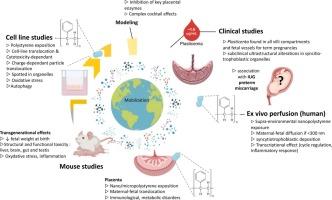塑料时代的第116年:潘多拉的盒子是怀孕的定时炸弹?产前塑料暴露的临床和基础资料综述
IF 11.3
1区 环境科学与生态学
Q1 ENGINEERING, ENVIRONMENTAL
引用次数: 0
摘要
在胎盘暴露的背景下,塑料构成了一个越来越感兴趣的领域。越来越多的证据表明,人类胎盘中存在各种微塑料和纳米塑料,包括聚苯乙烯、聚丙烯、聚乙烯和聚氯乙烯,从胎盘基底到胎膜都有。体外和离体研究的结果表明,这些环境污染物可以进入母体血液并到达胎盘,在那里它们集中在合胞滋养细胞中。即使在没有并发症的怀孕中也观察到这些所谓的“可塑性”,迄今为止,没有纵向研究证实对新生儿有害的长期后果。然而,塑料似乎会改变胎盘功能,因此可能与流产、宫内生长受限和早产等不良后果有关。人体离体研究、小鼠体内模型和微纳米塑料体外实验的结果表明,颗粒类型、大小、浓度、表面功能化、暴露途径和环境条件等因素在细胞摄取和随后的细胞功能和表型改变中起关键作用。因此,胎盘代谢和免疫功能的各种损伤可能导致胎盘和胎儿的异常发育。母亲暴露于这些无处不在的环境污染物可能导致产前和新生儿疾病状态。在这篇综述中,我们研究了目前关于胎盘中微塑料和纳米塑料的发生、分布和影响的临床、体内和体外数据。本文章由计算机程序翻译,如有差异,请以英文原文为准。

Year 116 of the Plastic Age: a Pandora’s Box as a Time Bomb for Pregnancy? Review of Clinical and Fundamental Data on Prenatal Exposure to Plastics
Plastics constitute an area of growing interest within the context of the placental exposome. A growing body of evidence now indicates that various micro- and nanoplastics — including notably polystyrene, polypropylene, polyethylene, and polyvinyl chloride — are present in the human placenta, from the basal plate to the fetal membranes. Results from in vitro and ex vivo studies have shown that these environmental pollutants can enter the maternal bloodstream and reach the placenta, where they concentrate in the syncytiotrophoblast. These so-called “plasticenta” have been observed even in uncomplicated pregnancies, and to date, no longitudinal study has confirmed harmful long-term consequences for the newborn. However, plastics appear to alter placental functions and may therefore be associated with adverse outcomes such as miscarriage, intrauterine growth restriction and preterm birth. Findings from ex vivo human studies, in vivo murine models, and in vitro experiments with micro- and nanoplastics indicate that factors such as particle type, size, concentration, surface functionalization, route of exposure, and environmental conditions play key roles in cellular uptake and subsequent alterations in cell function and phenotype. Consequently, various impairments in placental metabolic and immune functions may contribute to abnormal development of the placenta and the fetus. Maternal exposure to these ubiquitous environmental pollutants may induce prenatal and neonatal disease states. In this review, we examine the current clinical, in vivo and in vitro data on the occurrence, distribution and impact of micro- and nanoplastics in the placenta.
求助全文
通过发布文献求助,成功后即可免费获取论文全文。
去求助
来源期刊

Journal of Hazardous Materials
工程技术-工程:环境
CiteScore
25.40
自引率
5.90%
发文量
3059
审稿时长
58 days
期刊介绍:
The Journal of Hazardous Materials serves as a global platform for promoting cutting-edge research in the field of Environmental Science and Engineering. Our publication features a wide range of articles, including full-length research papers, review articles, and perspectives, with the aim of enhancing our understanding of the dangers and risks associated with various materials concerning public health and the environment. It is important to note that the term "environmental contaminants" refers specifically to substances that pose hazardous effects through contamination, while excluding those that do not have such impacts on the environment or human health. Moreover, we emphasize the distinction between wastes and hazardous materials in order to provide further clarity on the scope of the journal. We have a keen interest in exploring specific compounds and microbial agents that have adverse effects on the environment.
 求助内容:
求助内容: 应助结果提醒方式:
应助结果提醒方式:


